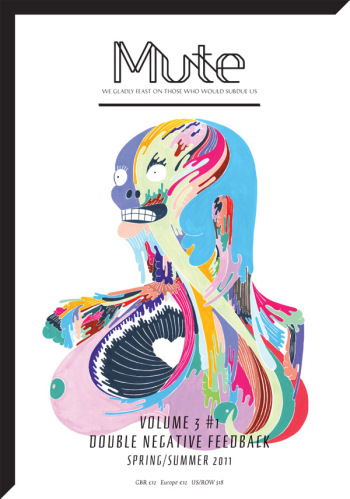Mute, 3(1): Double Negative Feedback (2011)
Filed under magazine | Tags: · architecture, art, capitalism, contemporary art, cultural politics, economics, financial crisis, journalism, music, neoliberalism, networks, politics, uk, wikileaks

“‘Double Negative Feedback’ expresses the hope that the chaos unleashed by the cybernetic loops of financialisation, post-Fordist production and networked life might not only be entropic and exploitative. The noise generated by ‘positive feedback’ also takes the form of the explosions we are seeing in the Arab world, the anti-disciplinary uses of cybernetic control systems, the ‘shared precarity’ of compositional improvising, and the ripples of a political organising that no longer assumes a common identity but instead acknowledges our common vulnerability. This issue scouts out such double-negative loops in a landscape dominated by the relentless, if often misfiring attempt to put feedback to work.”
Edited by Josephine Berry Slater
Publisher Mute, London, June 2011
Sabine Bitter, Helmut Weber: Autogestion, or Henri Lefebvre in New Belgrade (2009)
Filed under book | Tags: · architecture, city, self-organization, urbanism, yugoslavia

“The artist book by Sabine Bitter and Helmut Weber is based on an unpublished orginal text by French philosopher and urbanist Henri Lefebvre which is printed as a facsimile. This central text is contextualized and interpretated by accompanying commentaries and texts by Ljiljana Blagojevic, Zoran Eric, Klaus Ronnberger, and Neil Smith.
The text from Henri Lefebvre was submitted as part of a proposal with French architects Serge Renaudie and Pierre Guilbaud for the International Competition for the New Belgrade Urban Structure Improvement in 1986, sponsored by the state of Yugoslavia. In his urban vision for New Belgrade—the capital of former Yugoslavia founded in 1948—Lefebvre emphasizes the processes and potentials of self-organization of the people of any urban territory to counter the failed concepts of urban planning from above. For Lefebvre, at this late point in his life, the promises of both modernist capitalist as well as state socialist architecture and city planning had failed. Yet, Lefebvre viewed New Belgrade and Yugoslavia as having a particular position in what he has elsewhere called “the urban revolution.” As Lefebvre states, “because of self-management, a place is sketched between the citizen and the citadin, and Yugoslavia is today [1986] perhaps one of the rare countries to be able to pose the problem of a New Urban.””
Edited by Sabine Bitter, Jeff Derksen, and Helmut Weber (Urban Subjects)
With contributions by Sabine Bitter and Helmut Weber, Ljiljana Blagojevic, Zoran Eric, Klaus Ronnberger, and Neil Smith
Publisher: Sternberg Press, with Fillip, Vancouver, 2009
ISBN 9781933128771
160 pages
DJVU (6 MB, updated on 2013-12-8)
Comments (7)Roy Ascott (ed.): Art, Technologies, Consciousness: mind@large (2000)
Filed under book | Tags: · architecture, art, artificial life, computer music, consciousness, interactivity, metaphysics, music, perception, performance, quantum mechanics, robotics, semiotics, synaesthesia, technoetics, technology, telematics

Within a technological context, this volume addresses contemporary theories of consciousness, subjective experience, the creation of meaning and emotion, and relationships between cognition and location. Its focus is both on and beyond the digital culture, seeking to assimilate new ideas emanating from the physical sciences as well as embracing spiritual and artistic aspects of human experience.
Developing on the studies published in Roy Ascott’s successful Reframing Consciousness, the book documents the very latest work from those connected with the internationally acclaimed CAiiA-STAR centre and its conferences. Their artistic and theoretical research in new media and art includes aspects of:
• artificial life
• robotics
• technoetics
• performance
• computer music
• intelligent architecture
• telematic art
With profound insights for those in fields of Art, Media and Design – both academics and professionals — this book will also provide new ideas for software designers working on material to be used by the arts community.
Publisher Intellect Books, 2000
ISBN 1841500410, 9781841500416
204 pages
PDF (updated on 2012-7-24)
Comment (1)
